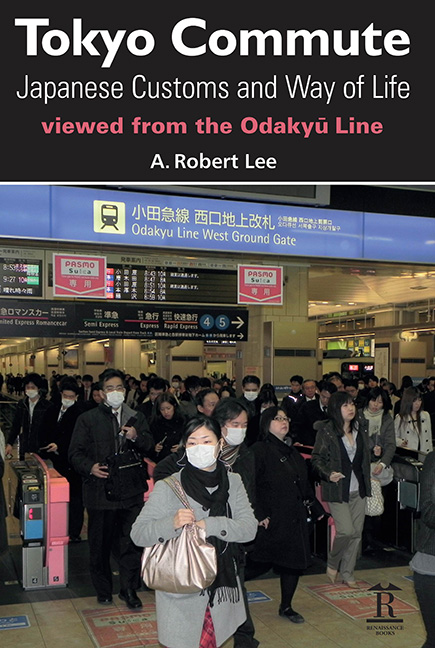Book contents
- Frontmatter
- Dedication
- Acknowledgements
- Contents
- 1 Odakyū-sen
- 2 Shinjuku Station
- 3 Shinjuku
- 4 Mukōgaoka-yūen North
- 5 Mukōgaoka-yūen South
- 6 Mukōgaoka-yūen Platform
- 7 January Monday
- 8 Odakyū Notables
- 9 Odakyū Line Sounds Familiar
- 10 Train Notices
- 11 Odakyū Commercials
- 12 February Tuesday
- 13 Odakyū Keitaispracht
- 14 By-line, Setagaya Line
- 15 March Wednesday
- 16 Odakyū Day-out Sendagi
- 17 Shimo-Kitazawa
- 18 Bicycle!
- 19 Odakyū Bike Interview – Toda-san
- 20 International Interlude via Narita Airport
- 21 Keitai Train Culture
- 22 April Thursday
- 23 Odakyū Tamagawa
- 24 Station Sights
- 25 Odakyū-sen, Yoyogi-Hachiman Eki
- 26 May Friday
- 27 Mukoōgaoka-yūen, Day for Night
- 28 Odakyū Day-out, Hakone
- 29 June Saturday
- 30 Odakyū Commercials
- 31 Odakyū Smokes
- 32 By-line, Nambu Line
- 33 Odakyū Bag Watch
- 34 Seijo Times
- 35 Odakyū Day-out, Yokohama
- 36 July Sunday
- 37 Odakyū Trains of Thought
- 38 Train Signs, Train Sounds
- 39 By-line, Tama Express
- 40 August Monday
- 41 Odakyū Day-out, Chiba
- 42 September Tuesday
- 43 Odakyū Lady-grooming
- 44 Odakyū and Near-Odakyū Women’s Hairday
- 45 Odakyū Evenings-out
- 46 October Wednesday
- 47 Odakyū Day-out, Ibaraki
- 48 Chikan! Odakyū Misbehaviour
- 49 November Thursday
- 50 Odakyū Blues
- 51 Odakyū Men’s Haircut
- 52 Odakyū Day-out, Ō-Sumo
- 53 December Friday
- 54 Odakyū Store
- 55 Odakyū Bookshelf
- 56 Last Train
- Glossary
- Frontmatter
- Dedication
- Acknowledgements
- Contents
- 1 Odakyū-sen
- 2 Shinjuku Station
- 3 Shinjuku
- 4 Mukōgaoka-yūen North
- 5 Mukōgaoka-yūen South
- 6 Mukōgaoka-yūen Platform
- 7 January Monday
- 8 Odakyū Notables
- 9 Odakyū Line Sounds Familiar
- 10 Train Notices
- 11 Odakyū Commercials
- 12 February Tuesday
- 13 Odakyū Keitaispracht
- 14 By-line, Setagaya Line
- 15 March Wednesday
- 16 Odakyū Day-out Sendagi
- 17 Shimo-Kitazawa
- 18 Bicycle!
- 19 Odakyū Bike Interview – Toda-san
- 20 International Interlude via Narita Airport
- 21 Keitai Train Culture
- 22 April Thursday
- 23 Odakyū Tamagawa
- 24 Station Sights
- 25 Odakyū-sen, Yoyogi-Hachiman Eki
- 26 May Friday
- 27 Mukoōgaoka-yūen, Day for Night
- 28 Odakyū Day-out, Hakone
- 29 June Saturday
- 30 Odakyū Commercials
- 31 Odakyū Smokes
- 32 By-line, Nambu Line
- 33 Odakyū Bag Watch
- 34 Seijo Times
- 35 Odakyū Day-out, Yokohama
- 36 July Sunday
- 37 Odakyū Trains of Thought
- 38 Train Signs, Train Sounds
- 39 By-line, Tama Express
- 40 August Monday
- 41 Odakyū Day-out, Chiba
- 42 September Tuesday
- 43 Odakyū Lady-grooming
- 44 Odakyū and Near-Odakyū Women’s Hairday
- 45 Odakyū Evenings-out
- 46 October Wednesday
- 47 Odakyū Day-out, Ibaraki
- 48 Chikan! Odakyū Misbehaviour
- 49 November Thursday
- 50 Odakyū Blues
- 51 Odakyū Men’s Haircut
- 52 Odakyū Day-out, Ō-Sumo
- 53 December Friday
- 54 Odakyū Store
- 55 Odakyū Bookshelf
- 56 Last Train
- Glossary
Summary
RIVER RUNS
TRAIN BRIDGE
You are out for a stroll, river-side. Take a glance in the direction of the bridge. Back and forth pelt the Odakyū trains. Expresses and Locals in their cream-and-blues. Romance cars each in their identifying colours.
CAR BRIDGE
A VIEW FROM THE BRIDGE
You are crossing the newly widened rail-bridge between Noboritoeki and Izumi-Tamagawa-eki. To the north and south flows, or rather half-flows, the Tama river. The Tamagawa. Heartening sight. A wide stretch of running water to irrigate, and confound, the square upright geometry of the bankside residence-blocks. Odakyū trains become viewing-platforms, box-seats, mobile verandas. Geographers will confirm that the Tamagawa begins high in Yamanashi Prefecture, heads into Lake Okutama and then winds across the Kanto Plain via Noborito and elsewhere until it spills into the Tokyo Bay. Its up-country runs are familiar kayak and canoe hang-outs. Bikes can be hired to ride its banks. Flora and fauna buffs walk its surrounds. It holds a fond place in many a Japanese and Tokyo day-out memory. Childhood walks. Swimming. Outdoor lunches. Plain messingabout.
FLOOD BARRIER
Placid as for the most part the Tamagawa seems, it can rile up on occasion, especially in Tokyo typhoon weather. To that end a barrier has been built. Like rivers throughout Japan the Tamagawa is thus subject to the concrete treatment (annually Japan uses more concrete than the USA). In a way you favour the barrier if indeed it is a lifesaver, a hedge against serious flood. On the other hand it takes on the look of river genetic engineering, a species of surgery against nature. No doubt it has to be, but a pity.
A BEND IN THE RIVER
The river itself, plus reeds, birds, the flip of a small fish, light eddies and currents, all make a perfect counter to the trains. Their rhythm and sound are given perspective. The water as ever in Japan serves as respite, a tranquility.
BAIT AND TACKLE
‘Look at the crowds of water-gazers there’.
Herman Melville, Moby-Dick
What more congenial sight as you speed this way or that aboard the Odakyū than the Spring-to-Autumn, dawn-to-dusk, local fishermen out (or even not especially out?) to make a catch.
- Type
- Chapter
- Information
- Tokyo CommuteJapanese Customs and Way of Life Viewed from the Odakyū Line, pp. 92 - 95Publisher: Amsterdam University PressPrint publication year: 2011



